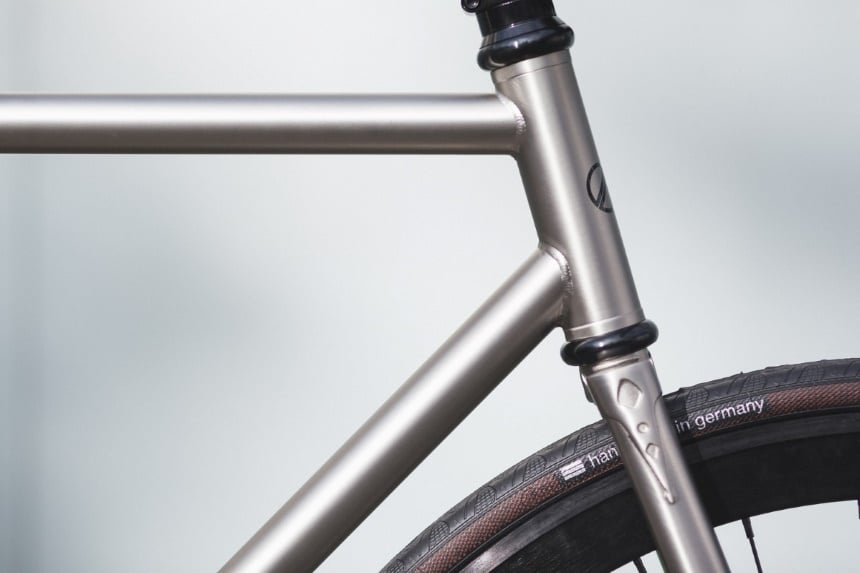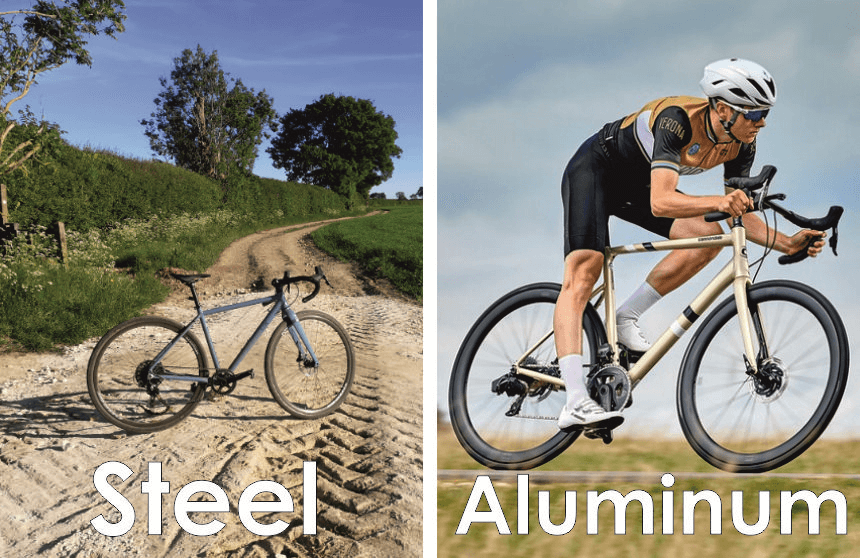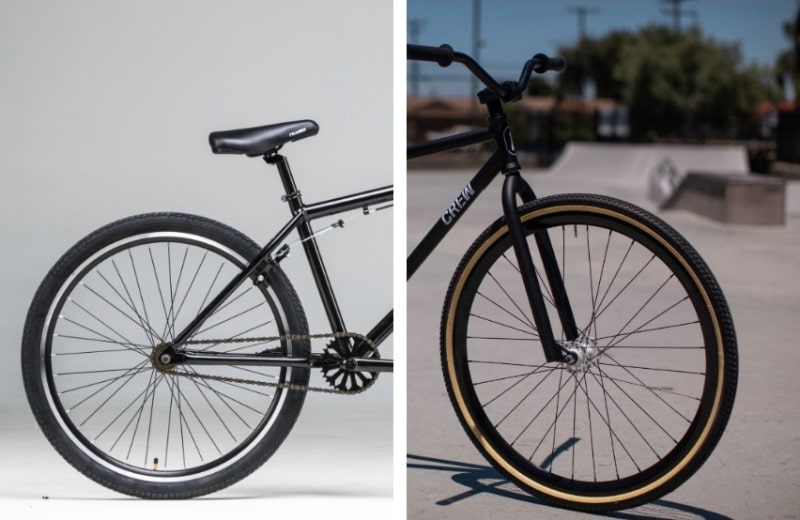- Trails
-
Bikes
-
Gear
-
Tips & Tricks
-
About us


When buying a bicycle, you face many questions. In addition to determining the basic model you want – BMX, MTB, or classic city bike – the frame size, the look, and much more also play a role. Above all, however, the material is important to be completely satisfied with the bike later on.
Many people are therefore faced with the question: steel or aluminum frame? To make your choice easier, in this steel vs. aluminum bike frame comparison article, we would like to explain the individual advantages and disadvantages of the two materials and give you practical tips and care instructions that increase the longevity of each material – whether steel frame or aluminum frame. So, what to choose: aluminum or steel bike? Let’s take a closer look.
Bicycles have a tradition that now goes back more than 200 years. A wide variety of materials are tested again and again to create the perfect bicycle. Steel in particular has prevailed over the long term and was one of the favored materials in bicycle manufacture then as it is now.
However, new findings of the last few years have left many people faced with the question: steel or aluminum bike?
Since each material has its advantages and disadvantages, the decision between steel vs aluminum cycle can only be made if the exact purpose of the bicycle is determined in advance and the material is selected according to these requirements.
| Steel (Hi-Ten or Cromoly) | Aluminum | |
| Strength and durability | Longer useful life with great resistance to fatigue | Not as strong and durable |
| Ease of repair | Easier to weld in case of breakage | Repairing is quite difficult |
| Weight | Steel is heavier than aluminum | Ultralight and aerodynamic material |
| Resistance to rust | Sensitive to oxidation | Resistant to rust and oxidation |
Depending on which properties are particularly important to you, you should also choose the material of your bike: steel vs aluminum accordingly. This is the only way to ensure that you are subsequently satisfied with the quality of the bike in everyday life.
Of course, the right material cannot be automatically selected using a short table. So that you can be sure that you will be able to enjoy your future bike for a long time, we have prepared a little material knowledge about steel frames and aluminum frames for you. Here, we intensively examine the advantages and disadvantages of the various materials. So you can easily decide whether you want a steel frame or an aluminum frame or whether you prefer higher-priced materials such as carbon or titanium.

Steel is famous for its durability, strength, and versatility. Steel bicycles tend to be priced less than models made from other materials. In addition, the steel will better resist any possible accident. If you prevent it from rusting, chances are your children, if not your grandchildren, can use your old steel bike.
Due to its particularly high weight and low stiffness, steel was rarely used in the manufacture of bicycles for many years. The comparatively cheap material only played a role for steel lovers with traditional ideas – in everyday life, however, primarily aluminum and carbon frames were used.
However, this changed abruptly when particularly stable and robust steel frames were developed, which are also considered to be completely rust-free. So, especially with regard to weight – the paint could be saved.
Many cyclists wonder whether aluminum bikes are lighter than steel. The answer is that steel is a comparatively heavy material to this day. It can hardly keep up with its competitors which are made of carbon or aluminum in terms of lightness. Its above-average longevity and the modern corrosion protection in innovative steel variants make the steel frame a practical alternative.
So if you are looking for a cheap bike that has high durability and ride comfort, a steel frame is well advised.

However, there is also a disadvantage of aluminum bike frames. The main negative aspect of the aluminum bike frame is that it has a lower resistance to shocks and weight compared to steel. So too much baggage or an accidental blow could deform the metal and weaken the bike.
With the beginning of the production of aluminum frames at the end of the 80s, steel was replaced as the main material for bicycles by most brands. With the classic aluminum frame, the main focus is on thin-walled tubes with a large volume, which has an excellent ratio between weight and rigidity.
Aluminum stands for above-average durability and low weight, which is almost entirely at the expense of comfort. The cushioning that every frame material offers while riding is by far the worst on aluminum bicycles.
You should also note that every aluminum bicycle is protected against corrosion, which significantly increases the maintenance effort. In everyday life, make sure that you always handle the aluminum bike with care, as the risk of dents in the aluminum frame due to the thin tubes is particularly high. Nevertheless, aluminum is an excellent material for bicycles, especially with regard to everyday suitability in terms of price-performance ratio.
Below is a side-by-side evaluation of both materials based on material properties.

It better absorbs vibrations transmitted by the terrain, which makes it more comfortable, especially on dirt tracks. It may seem silly or somewhat imperceptible, but in certain conditions, the comfort of steel is defended by many cyclists. Keep that in mind when deciding between steel vs aluminum gravel bikes.
However, aluminum is more flexible than steel. But to achieve the same strength of the frame, aluminum requires larger tube sections, resulting in stiffer frames.
For this reason, a steel frame will have better behavior against vibrations, which makes them, a priori, more comfortable bicycles, although the difference in comfort is not as noticeable as is usually claimed and depends more on other factors. Remember it when deciding on an aluminum frame vs a steel frame for cycling.
Are you going to buy a bicycle that will last you a lifetime or do you plan to change it in a year? Do not forget that all materials suffer wear and tear with the passage of time and the intensity of use. But some wear out before others. Steel, for example, rusts more easily than aluminum, but its durability is also greater.
In terms of durability, steel wins. It is much more resistant to breakage than aluminum, both due to the stress and fatigue of the material. However, in aluminum bicycles of a certain quality, it is difficult to break the frame.
Being the most used material in the construction of bicycles, alloys and welds have been greatly improved, making these frames practically unbreakable. The best proof of this is that most prestigious brands guarantee the frame for life. So, when deciding between steel vs aluminum road bike, keep that in mind.
It is true that when a frame breaks in some remote locality, it is much easier to find someone capable of welding steel than aluminum. But that already depends on the type of trips you are going to do.
If your trips will be through Africa, Asia, or you are going to be very heavily loaded, steel is better. Although it must be emphasized that frame breakage is one of the less common breakdowns that you can have. Also, the material will be determined by the specific type you want. Everyday road bikes and gravel bikes are mostly made with aluminum. Rugged, rough-terrain bikes are usually best produced with steel. These include mountain bikes and fat-tire bikes. A typical example of the latter type is the Mongoose Malus Adult Fat Tire Mountain Bike. It has a rugged steel frame, mechanical disc brakes, and is an under $500 bike.
Comparing steel vs aluminum bike frame weight, aluminum wins by a landslide. Steel weighs about three times more than aluminum and is up to 250% denser than aluminum.
This difference is mitigated a bit because the steel bikes allow you to mount thinner tubes and by using less material, they reduce the weight a bit. Even so, for a frame with the same resistance, the steel one will always be heavier.
However, as we go to higher quality steel alloys (such as the famous Cromoly) the difference in weight is reduced a lot but can increase the price. In any case, weight in cycling is not a factor of vital importance, and comfort or resistance prevails when you choose between steel vs aluminum hardtail.

In the case of steel, for humid or coastal climates, you must pay special attention to this maintenance and especially to the place and conditions where the bicycle “sleeps”, since this can greatly shorten the useful life of the frame.
Comparing steel vs aluminum bike frames, one of the reasons why many people opt for a steel frame is because they produce slimmer bikes with more classic lines, allowing for smaller and straighter tube sections that would not be feasible on aluminum. It can be a compelling reason for some people that is why we mention it.
The next consideration when deciding between aluminum vs steel bike frames is the price. In the production of a painting, it is partly associated with the cost of the material, which in turn depends on its quality. That is why we can find cheaper steel frames than other aluminum frames and vice versa. Most expensive gravel bikes come in aluminum materials but this material is versatile. It can be found in all price ranges, from cheap gravel and road bikes to mountain bikes.
For example, the Schwinn Bonafide Mens Mountain Bike is made of aluminum. It features a 17-inch aluminum frame and costs just a bit over $500.
However, if we match the qualities, the steel frame will normally be more expensive than the aluminum frame and this difference is given by the cost of production.
Aluminum frames, being predominant in the market, have lower costs, which are unfeasible for steel.
Finally, it should be mentioned that at the level of bicycle models, aluminum wins by a landslide in all categories. Aluminum is more common as it is more flexible to all types of users. You can find aluminum in cheap bikes as well as in high-quality and premium models.
There are still other types of frame materials found in bicycles. These include:

In terms of weight, carbon sets superlatives. No other material can be used to build bicycle frames as light as carbon. The appropriate alignment of the carbon fibers is crucial for the rigidity and comfort of a frame. For this reason, appropriate experience first had to be gained with this relatively new material. In the meantime, carbon processing has advanced so that frames that combine high stiffness in the area of the bottom bracket and the steering head with a high level of comfort can be built.
The durability of carbon is in principle unlimited. It is not subject to any aging process. Therefore, a carbon frame theoretically has an unlimited lifespan. However, this only applies as long as there are no external influences. The material is relatively sensitive to falling over or getting knocked, so it is not suitable for use on everyday bikes. Although there are now so-called carbon doctors who specialize in repairing broken or damaged carbon frames, the repair is time-consuming and correspondingly expensive.
Almost any shape can be created optically with carbon. For example, the current aero racing bikes and time trial machines would be inconceivable without the use of this artificial material. Keep that in mind when choosing between high-carbon steel vs aluminum bike.
Carbon frames are primarily used on high-quality (and unfortunately also correspondingly high-priced) racing bikes and mountain bikes, where weight plays a central role.

However, the raw titanium material is significantly more expensive than the three other materials and the processing is also quite complex. Therefore, titanium frames are extremely expensive.
Titanic frames for racing bikes and mountain bike hardtails are available. In some cases, these are also made to measure and then fit perfectly, like a made-to-measure suit. However, you should be ready to invest several thousand dollars in such a framework.
As you have seen in our steel vs. aluminum bikes comparison, no material is especially better than the other. While aluminum is the most widely used today, bicycles are still made out of steel materials.
Beyond the material, the important thing is that it is a recognized manufacturer and a design that adapts to the use that you are going to give your bicycle, and above all that it is of your size and with the appropriate geometry.
Now is the time to open the debate: Steel or aluminum? We, except for some very specific cases, prefer aluminum. Which do you prefer?





